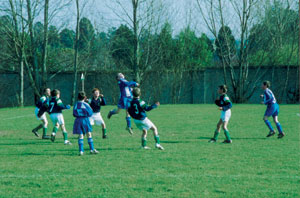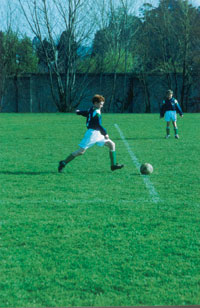| 2003 |

|
YEAR BOOK |
Trinity College Dublin and St James's Hospital, Dublin
|
Activity levels in children and their impact on cardiovascular risk factors
|

Inactivity is a modifiable risk factor for cardiovascular disease. Almost ten years ago, Watson (1993) reported that Irish children between 7 and 13 years were heavier, had higher skinfold thicknesses and lower aerobic endurance fitness scores than European children. In 2001 Hussey et al. surveyed 786 children between 7 and 9 years and reported that 14% of boys and 24% of girls were found to be doing less than the minimal volume of activity necessary to benefit the cardiovascular system. Time spent television watching by Irish children has been found to be at least two hours per day. This amount of time spent sedentary is of concern because it has been correlated to body fat.
The prevalence of obesity and overweight is increasing in both adults and children worldwide (WHO, 1997). Current data suggest that 20% of children in the US are overweight. In Northern Ireland, Yarnell et al. (2001) found that in 13 to 14 year olds 16% were overweight. As yet there are no data on percentages of overweight/obesity in children in the Republic of Ireland.
Overweight in children is associated with cardiovascular risk factors, and diseases that previously were only seen in adults - such as type 2 diabetes - are now being seen in children with obesity. Nolan and colleagues at the Metabolic Research Unit, St James's Hospital (Department of Clinical Medicine) have shown that early onset type 2 diabetes in Ireland, and other EU countries, is associated with severe obesity and insulin resistance. Studies in non-diabetic but equally obese people confirm that they too are insulin resistant.

There is a need to know the extent to which cardiovascular risk factors are present in children in Ireland and the extent to which they are associated with physical activity. Furthermore, there is a need to know if it is the overall energy expenditure in regular activity in children which is important, rather than activities for sustained periods. Activity levels in children are difficult to measure; traditional methods used in epidemiological studies in adults such as questionnaires have limitations in children due to the difficulty in recalling all their activities, and they may overestimate the time spent in activity or its intensity. We are currently working on the use of accelerometers (which measure movement in three dimensions) in capturing overall activity in this age group.
We will now begin a collaborative study to examine physical activity and fitness, overweight and obesity, blood pressure, lipids and glucose tolerance in children of 7 to 10 years from all socio-economic areas. This will provide important baseline data for Irish public health strategy, both for prevention and intervention in this modern epidemic disease.
References
Epstein LH, Paluch RA, Gordy CC, Dern J (2000) Decreasing sedentary behaviours in treating pediatric obesity. Arch Pediatr Adolesc Med, 154220-226
Hussey J, Gormley J. Bell C. (2001) Physical activity in Dublin children aged 7-9 years. BJSM, 35, 268-73.
Watson AWS, Derummy VJ (1993) Activity and lifestyle characteristics of Irish school children aged 10-13: a pilot study. COSPOIR report. Limerick: Brunswick Press Ltd.
WHO: www.who.int/en/
Yarnell JW, McCrum EE, Patterson CC, Skidmore P, Shields MD, McMahon J, Evans AE (2001) Prevalence and awareness of excess weight in 13-14 year olds in Northern Ireland using recent international guidelines. Acta Paediatrica 90:1435-9
Contact: Juliette Hussey, Lecturer in Physiotherapy, School of Physiotherapy Trinity Centre for Health Sciences, St James's Hospital, Dublin 8; Tel: (01) 608 2110 Fax: (01) 4531915; E-mail: [email protected] ;